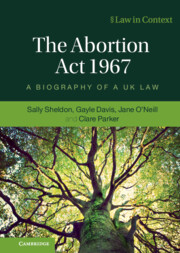Book contents
- The Abortion Act 1967
- Reviews
- Law in Context
- The Abortion Act 1967
- Copyright page
- Contents
- Acknowledgements
- Table of Cases
- Table of Legislation
- 1 Introduction
- 2 The Early Years
- 3 The Parliamentary Battle for Restrictive Reform
- 4 The Battle for Normalisation
- 5 The Battle for Legal Meaning
- 6 The Battle for Northern Ireland
- 7 The Parliamentary Battle for Modernising Reform
- 8 A Biography of the ‘Great Untouchable’
- Book part
- Bibliography
- Index
1 - Introduction
Published online by Cambridge University Press: 03 November 2022
- The Abortion Act 1967
- Reviews
- Law in Context
- The Abortion Act 1967
- Copyright page
- Contents
- Acknowledgements
- Table of Cases
- Table of Legislation
- 1 Introduction
- 2 The Early Years
- 3 The Parliamentary Battle for Restrictive Reform
- 4 The Battle for Normalisation
- 5 The Battle for Legal Meaning
- 6 The Battle for Northern Ireland
- 7 The Parliamentary Battle for Modernising Reform
- 8 A Biography of the ‘Great Untouchable’
- Book part
- Bibliography
- Index
Summary
This introdutory chapter describes events leading to the introduction of the Abortion Act. It explains the use of ’biography’ to frame the analysis, offers a brief synospsis of each chapter, discusses the sources used in the research and explains the choices made regarding terminology.
- Type
- Chapter
- Information
- The Abortion Act 1967A Biography of a UK Law, pp. 1 - 27Publisher: Cambridge University PressPrint publication year: 2022



